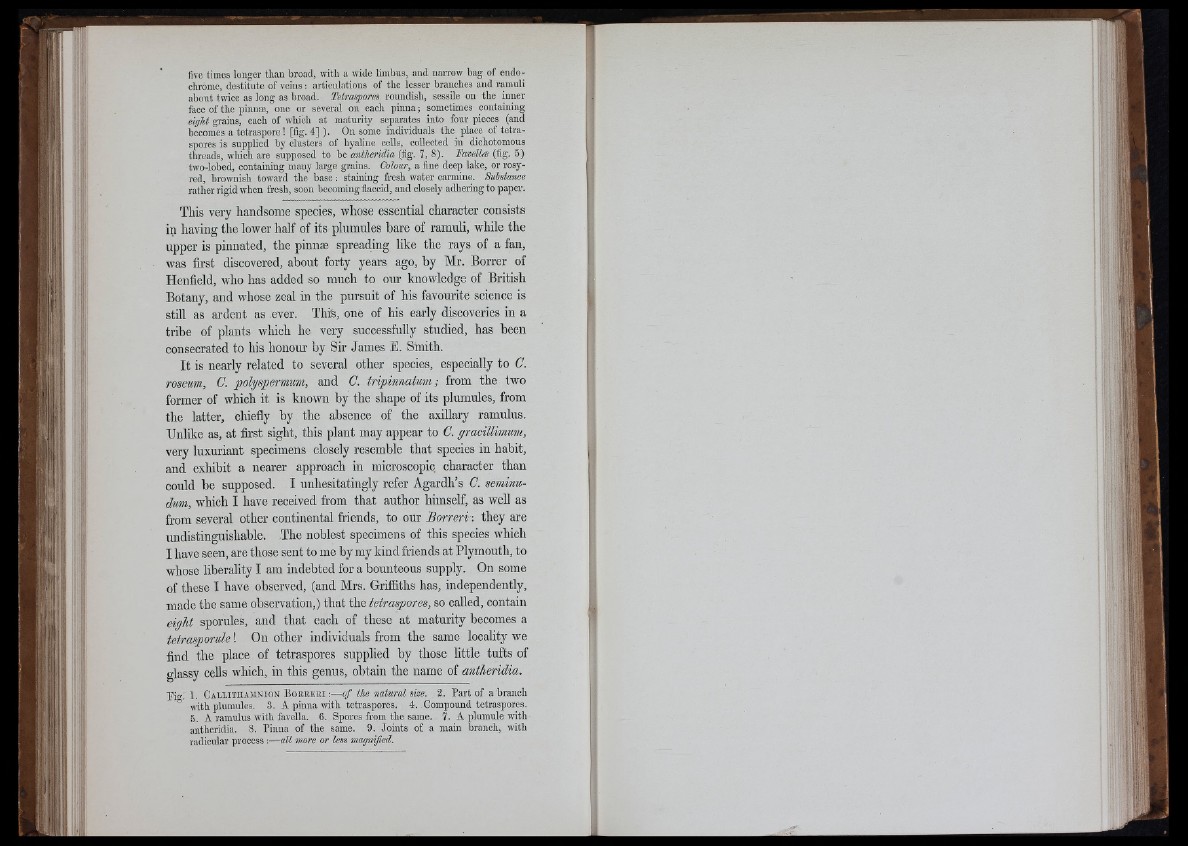
( J;
Y f 7 i' : ri I
five times longer tlian broad, with a wide limbus, and narrow bag of endochrome,
destitute of veins : articnlations of the lesser branches and ramuli
about twice as long as broad. Tetraspores roundish, sessile on the inner
face of the pinnæ, one or several on each pinna ; sometimes containing
eight grains, each of which at maturity separates into four pieces (and
becomes a tetraspore ! [fig. 4] ). On some individuals the place of tetraspores
is supplied by clusters of hyaline cells, collected in dichotomous
threads, which are supposed to be antheridia (tig. 7, 8). Pavellæ (fig. 5)
two-lobed, containing many large gi’ains. Colour, a fine deep lake, or rosy-
red, brownish toward the base : staining fresh water carmine. Substance
rather rigid when fresh, soon becoming flaccid, and closely adhering to paper.
This very handsome species, whose essentiai character consists
in having the lower half of its plumules bare of ramuli, while the
upper is pinnated, the piniiæ spreading like the rays of a fan,
was first discovered, about forty years ago, by Mr. Borrer of
Henfield, who has added so much to our knowledge of British
Botany, and whose zeal in the pursuit of his favourite science is
still as ardent as ever. Thfe, one of his early discoveries in a
tribe of plants which he very successfully studied, has been
consecrated to his honom' by Sir James E. Smith.
It is nearly related to several other species, especially to C.
roseum, C. polyspermum, and C. tripinnatum ; from the two
former of which it is known by the shape of its plumules, from
the latter, chiefly by the absence of the axillary ramulus.
Unlike as, at first sight, this plant may appear to C. gracillimum,
very luxuriant specimens closely resemble that species in habit,
and exhibit a nearer approach in microscopic character than
could be supposed. I unhesitatingly refer Agardh’s C. seminu-
dum, which I have received from that author himself, as well as
from several other continental friends, to our Borreri -. they are
undistinguishable. The noblest specimens of this species which
I have seen, are those sent to me by my kind friends at Plymouth, to
whose liberality I am indebted for a bounteous supply. On some
of these I have observed, (and Mrs. Griifiths has, independently,
made the same observation,) that tbe tetraspores, so called, contain
eight sporules, and that each of these at maturity becomes a
tetrasporule ! On other individuals from the same locality we
find the place of tetraspores supplied by those little tufts of
glassy cells which, in this genus, obtain the name of antheridia.
Fio-. 1. C.ALLIÏH.WINION BoEREKi :—o f the natural size. 3. Part of a branch
° with plumules. 3. A pinna with tetraspores. 4. Compound tetraspores.
5. A ramulus with favella. 6. Spores from the same. 7. A plumule with
antheridia. 8. Pinna of the same. 9. Joints of a main branch, with
radicular process :—all more or less magnified.
Î1 .